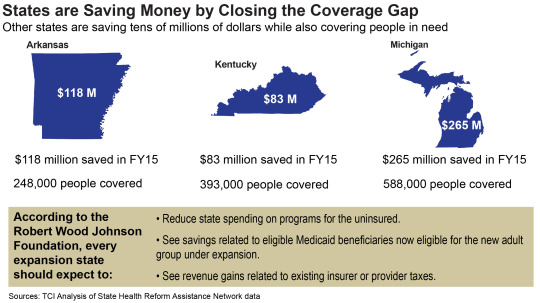December 15, 2015
Understanding Medicaid in Virginia
Virginia’s Medicaid plays an important role in connecting some of the most vulnerable residents with the health care they need. Yet despite its successes, and the reforms under way to make it better, there is still a lot of misinformation and misunderstanding about how the program works, how it improves health outcomes, and the opportunity state lawmakers have to improve it.
To help clarify and set the record straight we’ve updated our chartbook, How Medicaid Works, to provide an easy to read summary of key information and data critical to understanding the program today and the opportunity to close Virginia’s coverage gap like 30 other states and DC have.
The entire chartbook is published on our website, along with all the figures and graphs, as well as a full pdf version.
The chartbook updates previous work that shows the savings to the state, and it also includes new analyses documenting some of the unnecessary challenges Virginians face because of state lawmakers’ refusal to move forward on this common sense issue.
For example, under our current system nearly all children become ineligible for Medicaid on their 19th birthday. That contributes to a 2.5 percent decrease in the number of insured 19 year olds compared to their slightly younger counterparts.

Similarly, adult children can’t stay on their parents’ coverage after they turn 26. As a result there is a nearly 20 percent drop in the number of insured 26 year olds compared to 25 year olds.
And older Virginians are stuck in the position where they have increasing health needs but limited access to coverage until they turn 65 and qualify for Medicare. Hitting that milestone results in a 23.6 percent increase in the insured rate relative to people who are 64.
That’s a lot of numbers, but the point is that closing the coverage gap would help low-income people get the coverage they need and open the door to the health care they need. And the fact is states that moved forward with closing the coverage gap saw historic declines in the number of people without health insurance while Virginia has been left behind. Virginia’s neighboring states – like Kentucky, West Virginia, and Maryland – that accepted the federal funds to cover their low-income residents saw decreases that were drastically – in some cases three times – larger than in Virginia.
Add to that, the states that have opened their Medicaid programs to more low-income people have realized significant budgetary savings at the same time. That’s because states are now using federal funds to cover the health care needs of their low-income residents rather than state dollars for care through other safety net programs. Kentucky saved $83 million last year alone, and the savings are expected to outpace the costs into the next decade.

The revised chartbook has these and a host of other figures and data that lay out the case – again – for moving Virginia forward on a policy that can save the state money and improve the lives of hundreds of thousands of Virginians. It is time to close the coverage gap.
–Massey Whorley, Senior Policy Analyst
